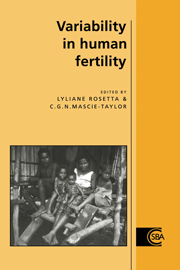1 - Introduction: the biological anthropological approach
Published online by Cambridge University Press: 03 February 2010
Summary
Concern over world population growth has led to many investigations of human fertility including, on a global scale, the ‘ World Fertility Survey ’. We certainly now know much more about the detailed nature of the ‘ population problem ’ than we did just a few years ago. But there are limitations to the broad-scale demographic methods which have been mainly used, especially in identifying the actual causes for fertility patterns, which are typically complex and interacting. Intense micro-studies are required for this, with detailed and prolonged social observations such as characterize anthropology.
Biological anthropology sees reproduction and fertility as part of an individual's whole life cycle and of a community's total ecology.
The ability to reproduce develops slowly over about a quarter of the life span, though much of the change is concentrated in a 3- or 4-year period. All stages are affected by various environmental influences, particularly nutrition, disease and altitude, as is well exemplified in the huge variation in the age of menarche and in its secular trend. During the mature years, fertility depends upon innumerable other factors than sexual behaviour; some of them obviously part of the reproductive process such as infant care practices, others acting indirectly through phenomena like maternal health, physical activity levels, and social life styles. It is important to take note of the fact that in many societies most adults, and particularly women, are working throughout the daylight hours and often into the night.
- Type
- Chapter
- Information
- Variability in Human Fertility , pp. 1 - 4Publisher: Cambridge University PressPrint publication year: 1996



